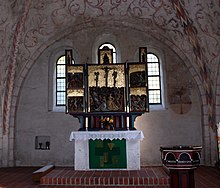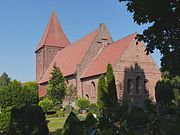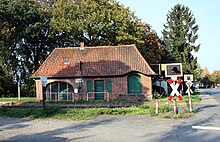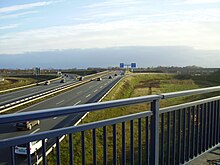Stuhr
| coat of arms | Germany map | |
|---|---|---|
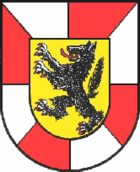
|
Coordinates: 53 ° 1 ′ N , 8 ° 45 ′ E |
|
| Basic data | ||
| State : | Lower Saxony | |
| County : | Diepholz | |
| Height : | 20 m above sea level NHN | |
| Area : | 81.66 km 2 | |
| Residents: | 33,611 (Dec. 31, 2019) | |
| Population density : | 412 inhabitants per km 2 | |
| Postal code : | 28816 | |
| Primaries : | 04206, 0421, 04221 | |
| License plate : | DH, SY | |
| Community key : | 03 2 51 037 | |
| LOCODE : | DE STU | |
| Community structure: | 8 districts | |
| Address of the municipal administration: |
Blockener Strasse 6 28816 Stuhr |
|
| Website : | ||
| Mayor : | Stephan Korte ( SPD ) | |
| Location of the municipality of Stuhr in the district of Diepholz | ||
Stuhr is an independent municipality in the north of the district of Diepholz ( Lower Saxony ) and with around 33,000 inhabitants the largest municipality in the district and the second largest municipality in Germany without city rights. It connects to the south of the city of Bremen . The municipality of Stuhr is a medium-sized center .
geography
Stuhr is located southwest of Bremen . Further neighboring communities are in the northwest the city of Delmenhorst , in the southwest the combined community Harpstedt , in the south the communities Bassum and Syke and in the southeast the community Weyhe . Stuhr is the most populous and economically strong municipality in the Diepholz district and, after Delmenhorst, one of the largest municipalities bordering Bremen. The elevations in some districts are part of the Geest (Ice Age landscape formation).
Districts
Stuhr consists of the districts Brinkum , Fahrenhorst , Groß Mackenstedt , Heiligenrode (Neukrug) , Moordeich , Seckenhausen , Stuhr and Varrel . The districts were independent communities until 1974. The place names indicate rural communities with bog soils and cleared areas.
The structures of the earlier parishes can still be seen in various respects. Many citizens of the former Oldenburg villages orientate themselves towards the middle center Delmenhorst as well as towards Bremen and Oldenburg. The residents of the former Hanoverian communities see themselves more as Buten-Bremer . The Protestant Stuhrer parishes belong to two different Protestant regional churches and the Catholic Church to two dioceses. Stuhr is supplied with three independent, competing daily newspapers: Bremer Nachrichten / Weser-Kurier with the regional edition Regional Rundschau as a supplement, Kreiszeitung Syke and Delmenhorster Kreisblatt with a Stuhr part.
Due to the proximity to Bremen, there are row and single-family housing estates for commuters in Brinkum, Varrel and Moordeich, which are grouped around the old town centers. Stuhr, with its economic power, has more professional commuters than out-commuters.
Stuhr
- Location: 53 ° 1 ′ 32 " N , 8 ° 44 ′ 44" E ; 6 m above sea level NN
The most striking building of 'Alt'-Stuhr is a brick church typical of the area . It was built between 1180 and 1187 and is dedicated to St. Pankratius . The initially wooden structure was replaced by a stone structure in the 13th century. This was done in three construction phases: in the oldest the Romanesque choir, then the nave with its early Gothic cross vaults, and finally the massive vaultless tower from the 14th / 15th. Century. Until the 18th century there were two main entrances, one for women on the north wall and one for men on the south wall. The north entrance is bricked up today. In 1964 the church was renovated and fundamentally refurbished in 1986/87. The winged altar was probably made between 1500 and 1520. According to experts, it comes from a carving workshop in Bremen. Paintings that were also on the back of the altar were lost. In 1992 the altar was restored. Today there are various wall paintings in the interior. These were whitewashed during the Reformation, but later exposed again during renovation work.
At the end of the 1980s, a park "( Biotop )" with numerous bodies of water was created in Stuhr . Stuhr is also the administrative center of the municipality and is home to the town hall, built in the 1980s, which is also the site of numerous cultural events. Relevant infrastructure facilities for the entire community such as the police station and the social station are located right next to the town hall.
The hamlets of Stuhrbaum, Blocken / Obernheide and Kuhlen also belong to the Alt-Stuhr district, the latter bordering on Bremen. In this area, parts of Bremen Airport are on the Stuhrer area. In the vicinity of Kuhlen, the park to the left of the Weser forms a local recreation area.
The Stuhrgraben , which is hardly noticeable today, runs through Stuhr , which in earlier times was called "de sture" as a raging river and to which the municipality owes its current name.
Varrel
- Location: 53 ° 1 ′ 56 ″ N , 8 ° 41 ′ 57 ″ E
Varrel has been part of the municipality of Stuhr since the municipality reform in 1974. Since the early 1970s, Varrel has become a popular place to live with good public transport connections to Bremen and Delmenhorst . It borders seamlessly on Bremen and Delmenhorst. The border to Bremen is marked by the Varreler Bäke .
Great Mackenstedt
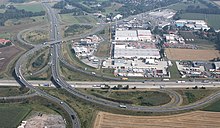
- Location: 52 ° 59 ′ 56 " N , 8 ° 42 ′ 12" E ; 10 m above sea level NN
Around 3,100 people live in Groß Mackenstedt. It is located about 17 kilometers southwest of Bremen.
Bog dike
- Location: 53 ° 1 ′ 45 " N , 8 ° 43 ′ 38" E ; 7 m above sea level NN
Moordeich has existed since 1143 and, in addition to some old farmsteads and many single-family housing estates from the 1960s and 1970s as well as 1990s and 2000s, is characterized by numerous commercial settlements. Moordeich has a primary school and a cooperative comprehensive school (Lise Meitner School).
The old town hall of the former municipality of Stuhr is also located in Moordeich, where part of the administration was housed until the 1980s. Today one of two branches of the community libraries is located in the building. Opposite the old town hall is the Gasthaus Nobel as the social center of the district as well as the modern shooting range of the most successful Stuhrer shooting club.
Moordeich borders directly on the Bremen district of Huchting , many people from Bremen are familiar with Moordeich because of the “oatmeal crossing” on the city limits. This name comes from the oatmeal production that has been based there for a long time.
Brinkum
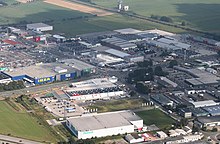
- Location: 53 ° 0 ′ 50 " N , 8 ° 47 ′ 16" E ; 4 m above sea level NN
Brinkum has been part of Stuhr since it was incorporated in 1974. With around 10,650 inhabitants (as of December 31, 2010), it is Stuhr's largest part of the community. It is located south of Bremen and borders seamlessly on the Bremen district of Kattenesch .
Heiligenrode
- Location: 52 ° 58 ′ 59 " N , 8 ° 42 ′ 33" E ; 12 m above sea level NN
Heiligenrode, located on the Klosterbach , impresses with its idyllic location. The well-preserved monastery church , the monastery mill, the monastery pond and the mill pond in the town center are witnesses to the formerly turbulent past of Heiligenrode, which originated over 865 years ago.
Seckenhausen
- Location: 52 ° 59 ′ 23 " N , 8 ° 45 ′ 48" E ; 9 m above sea level NN
The first documented evidence appears to appear in the second half of the 16th century. This village was apparently founded from small beginnings in the outskirts of Brinkum. If you drive through Seckenhausen, you might think that the transition from city to country takes place right here. A closed Bauernsiedlung you only meet in the 600 year old peasantry Wulf Hoop; otherwise the farms are isolated in the landscape. In between, however, some residential areas have emerged. In addition to the residential buildings, however, there are two industrial areas and numerous craft businesses along the B 322.
The place south of Brinkum was best known for the Tamsen luxury car dealership, which attracted rich customers across Germany, but has been in Hamburg since 2014. In addition, Seckenhausen has a primary school and an industrial park in which the largest plumbing and heating wholesaler in Germany, Cordes & Graefe, is based.
The Martin Luther Church in Seckenhausen was built in 1968; Inside and outside there are reliefs and color paths by Otto Herbert Hajek . Since 2005 it has had the largest photovoltaic system on a church roof in Northern Germany. On the first Friday of every month, Go! Seven, a “different service”, is celebrated there.
Fahrhorst
- Location 52 ° 57 ′ 13 " N , 8 ° 42 ′ 56" E ; 31 m above sea level NN
The district of Fahrenhorst is the southernmost part of the municipality of Stuhr. This district also includes Feine and Warwe , which are predominantly rural. Part of the town of Fahrenhorst lies in the forest.
In Fahrenhorst there are some clubs like the Schützenverein Fahrthorst von 1903 e. V., the skat club "Every quarter of an hour", as well as TSG Seckenhausen-Fahrenhorst and the football club Paradise City Fahrenhorst. Sights in Fahrenhorst are the many old half-timbered houses .
history
Unified municipality of Stuhr
In its current form, the municipality of Stuhr was created by the municipality reform on March 1, 1974. The old community of Stuhr with the districts Moordeich, Stuhr (including the districts Blocken, Stuhrbaum and Kuhlen) and Varrel belonged to the district and administrative district of Oldenburg . It was merged with the formerly independent communities of Brinkum, Fahrenhorst, Groß Mackenstedt, Heiligenrode (including the districts of Bürstel and Neukrug) and Seckenhausen and gave the new administrative unit its name as the most populous community. At the same time, the new municipality was added to the administrative district of Hanover , to which, for example, the municipality of Brinkum also belonged before, and so came to the district of Grafschaft Hoya . Due to the district reform in August 1977, the county of Hoya was dissolved and became part of the Diepholz district , to which Stuhr has belonged since then.
According to the State Office for Statistics Lower Saxony, the population has developed as follows - partly also as a result of the incorporation:
| Deadline | Residents |
|---|---|
| 05/17/1939 | 8,896 |
| 09/13/1950 | 13,855 |
| 06/06/1961 | 13,619 |
| 05/27/1970 | 18,683 |
| 05/25/1987 | 27,085 |
| December 31, 2015 | 33,083 |
| December 31, 2016 | 33,374 |
| December 31, 2017 | 33,526 |
Nationality
In the 11th to the beginning of the 13th century, the area around Stuhr belonged to the tribal duchy of Saxony . In 1234 Stuhr came into the possession of the Counts of Oldenburg and the rule of Delmenhorst. Brinkum then belonged to the diocese of Bremen ; it was sold to County Hoya in 1384 .
From the middle of the 17th century, Stuhr was successively Danish (1667), French (1679), Swedish (1700), Chur-Hanoverian (1711), Russian (1773), British-Hanoverian (1795) and again French in 1811. From 1815 Stuhr belonged again to Oldenburg.
History of the districts
Brinkum is mentioned in a document as a parish village of Brinscimibroch in 1063, when King Heinrich IV transferred land to the archbishopric church of Bremen-Hamburg.
Groß Mackenstedt - settled in the 8th century - could have got its name in 1171 after Friedrich von Mackenstedt, servant of the Archbishop of Bremen .
Heiligenrode was settled in the 8th century. A Benedictine monastery was built in 1182 . The place was mentioned in 1189.
Moordeich was mentioned in 1143. It was settled in the 16th century.
Seckenhausen was first named in a document in the second half of the 16th century.
Stuhr was first mentioned in a document in 1171 as a break along the river Sture , when Duke Heinrich the Lion and Archbishop Balduin I of Bremen granted Friedrich von Mackenstedt the settlement privilege according to Hollerrecht . In 1182 the place came largely under the monastic rights of Heiligenrode. The oldest building is the church in Alt-Stuhr from 1180/1187. After 1234 it came into the possession of the Counties of Oldenburg and Delmenhorst.
Varrel was first mentioned in 1289 as Verlebrinc .
Obernheide subcamp
A barrack camp for construction workers and prisoners of war was set up in Obernheide in 1939 and run by the Todt Organization . In 1942, after vacancies and interim uses, prisoners of war were again housed here. Flak soldiers were stationed here in June 1944 .
From September 1944, Obernheide was a satellite camp with 12 barracks of the Neuengamm concentration camp . 500 Hungarian Jewish women have now been housed here by the Hindenburg barracks in Bremen- Huckelriede . 300 female prisoners from Poland were added later. The prisoners had to carry out cleanup work in Bremen under the supervision of the SS . Serious mistreatment by SS guards became known after the war. On April 4, 1945, the prisoners were relocated to the Bergen-Belsen concentration camp . Many of them perished before the concentration camp was liberated on April 15, 1945.
A stone memorial by Wittmute Malik has stood here since 1988.
politics
Self-portrayal: In the late 1970s, the community advertised with the slogan “Stuhr is not stubborn”. Today's slogan is: "Together we are Stuhr".
Municipal council
The local elections on September 11, 2016 , September 11, 2011 , September 10, 2006 and September 9, 2001 led to the following results:
| Parties and constituencies | % 2016 |
Seats 2016 |
% 2011 |
Seats 2011 |
% 2006 |
Seats 2006 |
% 2001 |
Seats 2001 |
||
|---|---|---|---|---|---|---|---|---|---|---|
| CDU | Christian Democratic Union of Germany | 39.8 | 15th | 42.7 | 16 | 41.0 | 16 | 37.8 | 15th | |
| SPD | Social Democratic Party of Germany | 29.8 | 11 | 31.1 | 12 | 33.7 | 13 | 38.5 | 15th | |
| GREEN | Alliance 90 / The Greens | 12.0 | 5 | 15.4 | 6th | 8.8 | 3 | 7.3 | 3 | |
| BETTER | BESSER - citizens get involved eV | 9.7 | 4th | 6.1 | 2 | 5.5 | 2 | 4.3 | 1 | |
| FDP | Free Democratic Party | 8.7 | 3 | 4.0 | 2 | 11.1 | 4th | 12.1 | 4th | |
| total | 100 | 38 | 100 | 38 | 100 | 38 | 100 | 38 | ||
| voter turnout | 53.8% | 50.0% | 49.5% | 47.8% | ||||||
mayor
On June 16, 2019, Stephan Korte was elected full-time mayor of the municipality of Stuhr with 61.49% in the runoff election against the CDU candidate Frank Holle .
- Previous incumbent
- 1974–1991: Heinz-Wilhelm Schmidt (SPD)
- 1991-2001: Peter Schilbach (SPD)
- Nov. 2001 – Oct. 2011: Cord Bockhop (CDU)
- Feb. 2012 – Feb. 2020: Niels Thomsen (independent)
- since Feb. 2020: Stephan Korte (SPD)
- Mayor of Brinkum
- until 1970: Wassmann
- 1970–1974: Heinz-Wilhelm Schmidt (SPD)
coat of arms
Blazon : "Eightfold stiffened by silver and red , covered with a heart shield, inside in gold a soaring red-armored black wolf ."
Partnerships
-
Town twinning
- Canton d´Écommoy ( France )
- Alcalá de Guadaira ( Spain )
- Sigulda ( Latvia )
- Győr ( Hungary )
- Ostrzeszów ( Poland )
- Stuhr is represented in the Lower Saxony / Bremen municipal association.
Culture and sights
Buildings
- The Pankratius Church was at the beginning of the Gothic , in the 13th century, brick church , consecrated to Saint Pankratius . A previous wooden building was built between 1180 and 1187.
- In Brinkum, instead of a medieval church, a classicist hall church was built in 1842 according to plans by Friedrich August Ludwig Hellner .
- The monastery church St. Marien in Heiligenrode was built in 1300 in place of a previous building of 1182 and once belonged to a Benedictine - monastery . It is located with the cloister mill and the cloister pond on the cloister stream (see more under the Heiligenrode section).
- The old town hall with the community library is located in Moordeich, as well as the Moordeich park cemetery, built in 1990 based on the model of a north German geest landscape with the "Huus aft Diek" chapel by Bremen architect Harm Haslob with wall reliefs by Oldenburg artist Max Herrmann (1908–1999) .
- There are old half-timbered houses in Fahrenhorst .
- In Varrel there is Gut Varrel, a complex consisting of a manor house with a barn , a bakery and a water mill . The buildings have been restored since 1980 by the Gut Varrel Association and converted into a cultural meeting place.
- The Martin Luther Church from 1968 with reliefs by Otto Herbert Hajek is located in Seckenhausen .
Art in public space
- Brinkum, Briseck residential area on the square on Marsstrasse: Object art in the kindergarten made of Swedish granite by Igors Dobicins (1999).
- Heiligenrode in the pond of the watermill in the mill ensemble: Man does not live on bread alone ; Figure group in the water made of ceramic by Petra Förster (then scholarship holder in Heiligenrode) (1994/95).
- Heiligenrode in the choir of the monastery church: stained glass window by Gottlieb Pot d'Or (1964).
- Obernheide: Memorial to the subcamp of Neuengamme concentration camp in Stein by Wittmute Malik (1988).
- Seckenhausen in front of the adult education center: Rider's Head made of Swedish granite from the Latvian Igors Dobicins (2000).
- Stuhr in front of the town hall: wooden object stamped cross by Siegfried Pietrusky (1992).
- Stuhr before Kreissparkasse: Tower object from terracotta by Rita Bieler (1997).
Memorial plaques
Stuhr station memorial plaque: Since June 2005 there has been a memorial plaque commemorating an event from the Second World War : In 1944/45, Jewish women from Hungary were transported as prisoners of the Neuengamme subcamp in Obernheide / Stuhr from this railway station to Bremen , where they were forced to work had to perform. The board was set up by students from the Lise-Meitner School in Stuhr-Moordeich.
Economy and Transport
economy
The economy in Stuhr is characterized by small and medium-sized businesses. In addition to existing high-tech companies, the commercial landscape is strongly characterized by logistically oriented companies. Due to the convenient location in commercial areas, there are large-scale retail businesses and shopping opportunities. The “Ochtum Park” with outlet stores is located in the immediate vicinity of a motorway junction.
Large employers in Stuhr include a trading company for pipes, flanges and fittings (rff), a cheese dairy, a sanitary wholesaler, a tour operator and a component manufacturer. The German headquarters of the Flying Pizza franchise company is located in Brinkum . The Stuhrer Brewery Mühlen-Bräu has been closed since 2008. The Mackenstedter Kornbrennerei, on the other hand, is known regionally and the private brewery Braugut Stuhr in the district of Fahrenhorst has existed since 2014.
traffic
The autobahn triangle of the same name is located in the municipality of Stuhr and connects the federal freeway 28 coming from the Netherlands with the federal freeway 1 . The rural part of the municipality is mainly developed via the federal highways 6 and 51, which are also the main development for the southern areas. The community has transport links to Bremen Airport, which is partially located in the Stuhrer area. The Bremen ports are also easy to reach for entrepreneurs and employees in the community. There are plans to use the Moordeich – Leeste section of the Bremen-Thedinghauser Railway for the Bremen tram .
Infrastructure
General
- Town hall in Stuhr, Blockener Straße 6
- Stuhr local fire brigade with the local fire brigades Brinkum, Fahrenhorst, Groß Mackenstedt, Heiligenrode, Seckenhausen and Stuhr
- Police station Stuhr, Am Rathaus 5
education
- Five primary schools in Brinkum, Moordeich, Heiligenrode, Seckenhausen and Varrel
- Two cooperative comprehensive schools with all secondary school branches in Moordeich ( Lise Meitner School) (up to grade 10) and Brinkum (up to grade 12/13). The cooperative comprehensive schools were expanded into voluntary all-day schools.
Cultural institutions, associations
- Library Stuhr with two libraries in Brinkum and Moordeich
- KuSS is an art school in Stuhr.
- Stuhr-Heiligenrode artists' workshop in Stuhr, An der Wassermühle 5–10.
- Cultural associations:
- Art: Kunstverein Stuhr, Künstlerinnennetz Stuhr, Mach-Art.
- Local associations: Heiligenrode, Heimatbühne Stuhr, Sparclub-Varreler Krug.
- Choirs: Allegro Choir, Blocken, Brinkum, Concert Choir, Harmonie Moordeich, Shanty Choir Brinkum, church choirs of the Evangelical Church Congregation Seckenhausen, the Catholic Church Congregation St. Paulus in Moordeich, the Catholic Church Congregation Heilig Geist in Brinkum and the Evangelical Church Congregation Varrel
- Music: Blockener brass musicians, trombone choir of the Church of Heiligenrode, Klosterbläser Heiligenrode, Musikfreunde Stuhr
- Media and theater: Stuhrer Theaterkiste, Studio 7 - The media team, Stuhr media workshop, Varrel children's theater
- as well as the Gut Varrel development association, Sambrassa women's sambagruppe, Blocken village school.
- Studio Stuhr, a community radio from radio weser tv
- District music school of the district of Diepholz with the Syke office
- Stuhr plus - Forum Energy Efficient Building + Modernization from 2009
Social facilities
- Ten municipal kindergartens, a Catholic kindergarten and a Waldorf kindergarten
- Multi-generation houses in Brinkum (slotted spoon) and Fahrenhorst (Heilig-Geist-Kapelle parish hall)
- Four privately owned retirement homes in Brinkum, Fahrenhorst and Stuhr, as well as the possibility of living with service in Brinkum and Stuhr
Religions
Denomination statistics
According to the 2011 census , in 2011 46.4% of the population were predominantly Protestant , 8.3% Roman Catholic and 45.4% were non-denominational , belonged to another religious community or did not provide any information. Currently (as of December 31, 2019) of the population, 12,976 (37.8%) are Protestant, 2,760 (8.0%) Roman Catholic and the majority of 18,616 (54.2%) are non-denominational or belong to another religious community. The number of Protestants and Catholics has therefore decreased in the observed period.
Churches
- Ev. Lutheran parish Brinkum, Kirchstrasse 1
- Ev. Lutheran parish of Heiligenrode, on the monastery 5
- Ev. Lutheran parish Seckenhausen, Industriestr. 8th
- Ev. Lutheran parish Stuhr, Stuhrer Landstr. 142
- Ev. Lutheran parish of Varrel, Varreler Landstrasse 69
- Catholic community Heilig Geist, Brinkum, Heilig-Geist-Str. 1
- Catholic parish St. Paulus, Moordeich, Varreler Feld 7
Sports
- Sports facilities are u. a. the stadiums in Brinkum and Moordeich / Stuhr and the sports halls at the two secondary schools
- With a sporting offer with clubs in all parts of the village, sporting successes at the level of German championships in netball and shooting sports are on the success list of the community's athletes.
- Equestrian sport has a special place in the equestrian-friendly community.
Personalities
in chronological order according to the year of birth
Born in Stuhr
- Hans Helmers (1894–1982), politician (DVP / CDU)
- Paul Mehl (1912–1972), football player
- Walter Jasper (* 1942), radio commentator
- Gerd Wiltfang (1946–1997), Olympic and world champion in show jumping
- Joris (* 1989), musician
Lived or worked in Stuhr
- Heinrich Thümler (1887–1969), politician (NSDAP)
- Jürgen Timm (* 1936), politician (FDP)
- Hartmut Müller (* 1938), historian, archivist and researcher
- Karl Dall (* 1941), comedian, entertainer
- Dieter Burdenski (* 1950), soccer goalkeeper and sports shop owner
- Jonny Otten (* 1961), soccer player, shop for advertising technology
- Thomas Schaaf (* 1961), soccer player and coach
- Birol Ünel (* 1961) actor, received the German Film Prize in 2004
- Hans Theodor Hallier (1908–1982), painter
literature
- C.-H. Hüchting: 900 years of Brinkum 1063–1963. Brinkum 1963
- Erich Lemberg: The book of Stuhr, Volume I. Local history and local history of the community of Stuhr in Oldenburg. (Ed .: Stuhr municipality), Delmenhorst 1966, 292 p. M. numerous Fig.
- Erich Lemberg: The Book of Stuhr, Volume II. The old Stuhr - younger than ever today. For the 800th anniversary of the Stuhr community. (Ed .: Gemeinde Stuhr), Delmenhorst 1971, 136 p. M. Fig.
- Heiligenrode 1182–1982. Festschrift for the 800th anniversary. (Ed .: Municipality of Stuhr), Bremen 1982, 190 p. M. 66 Fig.
- Hartmut Müller : The women from Obernheide. Jewish forced laborers in Bremen 1944/45. Bremen 1988, 146 p. With 56 ills.
- Joachim Oltmann: Getting going again. The community of Stuhr in the post-war period 1945–1950. Brinkum, Fahrenhorst, Groß Mackenstedt, Heiligenrode, Moordeich, Seckenhausen, Stuhr, Varrel. (Ed .: Municipality of Stuhr), Fischerhude 1990, 232 p. M. Fig .; ISBN 3-88132-168-3
- Herbert Schwarzwälder : The large Bremen Lexicon , Bremen, 2002
- Brinkum. , Heiligenrode. u. Stuhr. In: Georg Dehio : Handbook of German Art Monuments . Bremen Lower Saxony. Munich / Berlin 1992, p. 297, p. 666 and p. 1261
- Gabriele Ullrich : About strong and weak women. Stuhr-Bremen-Weyher résumés from four centuries. Fischerhude 1996, 144 p. M. 47 fig.
- (Collective of authors; compilation and processing: Helmuth Riewe and Irmgard Mainusch): Little light and a lot of shadow. Stuhr 1933-1945. Memories of Stuhrer contemporary witnesses. (Ed .: Community Stuhr and Volkshochschule des Landkreis Diepholz), Stuhr 2006, 160 p. M. Fig.
- (Collective of authors; compilation and editing: Helmuth Riewe and Irmgard Mainusch): Hunger for bread and peace. Stuhr 1945–1948. Memories of Stuhrer contemporary witnesses. (Ed .: Community of Stuhr and Volkshochschule des Landkreis Diepholz), Stuhr 2007, 256 p. M. Fig.
- (Collective of authors): Life under the swastika 1933–1945. Contemporary witnesses from Heilgenrode and Groß Mackenstedt tell. Compilation and editing: Helmuth Riewe and Elisabeth Heinisch; Ed .: Community of Stuhr and community college of the district of Diepholz. Municipality of Stuhr, Stuhr 2008; ISBN 978-3-00-025809-1
Film (video production)
- Gabriele Ullrich : Obernheide wasn't everything. Memories of the Hungarian Jewess Lily Maor. (Documentation; 22 min.), 1995
- "1971 - 800 years of Stuhr" by Jürgen Buckmann u. Willi Lilienthal (documentation / rights: Stuhr municipality)
Web links
Individual evidence
- ↑ State Office for Statistics Lower Saxony, LSN-Online regional database, Table 12411: Update of the population, as of December 31, 2019 ( help ).
- ↑ http://www.stuhr-varrel.de/
- ^ Website of the municipality of Stuhr, accessed on August 22, 2015
- ↑ History | Company | Penske Sportwagen Hamburg GmbH. Retrieved May 22, 2017 .
- ^ Federal Statistical Office (ed.): Historical municipality directory for the Federal Republic of Germany. Name, border and key number changes in municipalities, counties and administrative districts from May 27, 1970 to December 31, 1982 . W. Kohlhammer GmbH, Stuttgart and Mainz 1983, ISBN 3-17-003263-1 , p. 190 .
- ↑ http://www1.nls.niedersachsen.de/statistik/html/default.asp
- ^ Herbert Black Forest : The Great Bremen Lexicon . Volume: supplementary volume . A – Z. Edition Temmen, Bremen 2008, ISBN 978-3-86108-986-5 , p. 131.
- ↑ http://wahl.stuhr.de/gw-2016/haben.html
- ↑ a b c http://wahl.stuhr.de/gw-2011/otal.html
- ↑ a b http://wahl.stuhr.de/gw-2006/otal.html
- ↑ a b http://wahl.stuhr.de/gmr-2001/
- ↑ http://www.derwesten.de/staedte/nachrichten-aus-kleve-und-der-region/schloss-wissener-handwerksbier-id11961900.html
- ↑ Stuhr Religion , 2011 census
- ↑ Stuhr Figures Data Facts , accessed on March 3, 2020




